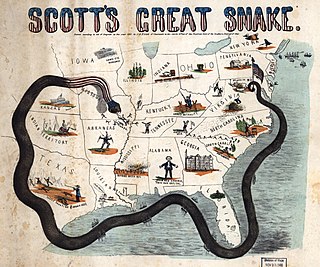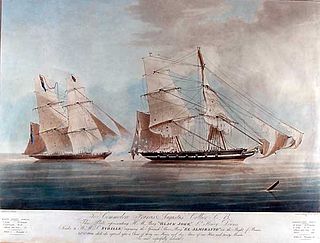
Bahia is one of the 26 states of Brazil, located in the Northeast Region of the country. It is the fourth-largest Brazilian state by population and the 5th-largest by area. Bahia's capital is the city of Salvador, on a spit of land separating the Bay of All Saints from the Atlantic. Once a monarchial stronghold dominated by agricultural, slaving, and ranching interests, Bahia is now a predominantly working-class industrial and agricultural state. The state is home to 7% of the Brazilian population and produces 4.2% of the country's GDP.
The third USS Dolphin was the brig in the United States Navy. Her plans were the basis of other brigs of that time. She was named for the aquatic mammal.

A blockade is the act of actively preventing a country or region from receiving or sending out food, supplies, weapons, or communications, and sometimes people, by military force. A blockade differs from an embargo or sanction, which are legal barriers to trade rather than physical barriers. It is also distinct from a siege in that a blockade is usually directed at an entire country or region, rather than a fortress or city and the objective may not always be to conquer the area.
The Brazilian Navy is the naval service branch of the Brazilian Armed Forces, responsible for conducting naval operations.

The Blockade of Africa began in 1808 after the United Kingdom outlawed the Atlantic slave trade, making it illegal for British ships to transport slaves. The Royal Navy immediately established a presence off Africa to enforce the ban, called the West Africa Squadron. Although the ban initially applied only to British ships, Britain negotiated treaties with other countries to give the Royal Navy the right to intercept and search their ships for slaves.

Benito de Soto Aboal Pontevedra is in Galicia in northern Spain where the language is close to Portuguese, which has confused some sources that say he was Portuguese. He was captain of the pirate ship Defensor de Pedro, sometimes incorrectly named as the Burla Negra, that was responsible for several piracies in the Atlantic in 1828, in a period of increased piracy following the independence of the new states of South America. The most notable attacks were on the British Indiaman Morning Star and the American ship Topaz, which involved great violence. De Soto was captured and tried in Gibraltar on 20 January 1830 and he was hanged on 25 January. Other members of his crew were captured in Spain. Their trial there began on 19 November 1829 and ten men were executed on 11 and 12 January 1830.

HMS Clio was a Cruizer-class brig-sloop of the Royal Navy, launched at James Betts' shipyard in Mistleythorn in Essex on 10 January 1807. Her establishment was 71 officers and men, 24 boys and 20 marines. She served in the Baltic during the Napoleonic Wars, accomplished the re-establishment of British rule on the Falkland Islands in 1833, and participated in the First Opium War. She was broken up in 1845.

HMS Sappho was a Royal Navy brig that gained public notoriety for causing a diplomatic incident over the slave trade with the United States of America and then went missing off the Australian coast in 1857–58.
William Rothery was chief of the office of the king's proctor in Doctors' Commons - a society of lawyers practising civil law in London.

The third HMS Black Joke was probably built in Baltimore in 1824, becoming the Brazilian slave ship Henriquetta. The Royal Navy captured her in September 1827, and purchased her into the service. The Navy renamed her Black Joke, after an English song of the same name, and assigned her to the West Africa Squadron. Her role was to chase down slave ships, and over her five-year career, she freed thousands of slaves. The Navy deliberately burnt her in May 1832 because her timbers had rotted to the point that she was no longer fit for active service.

The João Coutinho-class corvettes were a series of warships built for the Portuguese Navy for service in Portugal's African and Indian colonies. Initially rated as frigates, they were downgraded first to corvettes and then patrol vessels with age. They were designed in Portugal by naval engineer Rogério de Oliveira, but the urgent need of their services in the Portuguese Colonial War meant that the construction of the ships was assigned to foreign shipyards. Six ships were built; the first three ships were built by Blohm & Voss and the remaining three by Empresa Nacional Bazán. The ships were launched in 1970 and 1971. The relative cheap cost of the design led to it being the basis of several other classes in other navies. From 1970 until the end of the conflict in 1975, the corvettes were used for patrol and fire-support missions in Angola, Mozambique, Guinea and Cape Verde. After the African colonies gained their independence, the corvettes were assigned to patrol duties in Portuguese territorial waters.

Sibylle was a 38-gun Hébé-class frigate of the French Navy. She was launched in 1791 at the dockyards in Toulon and placed in service in 1792. After the 50-gun fourth rate HMS Romney captured her in 1794, the British took her into service as HMS Sybille. She served in the Royal Navy until disposed of in 1833. While in British service, Sybille participated in three notable single-ship actions, in each case capturing a French vessel. On anti-slavery duties off West Africa from July 1827 to June 1830, Sybille captured many slavers and freed some 3,500 slaves. She was finally sold in 1833 in Portsmouth.
Guerrero was a Spanish slave ship that wrecked in 1827 on a reef near the Florida Keys with 561 Africans aboard. Forty-one of the Africans drowned in the wreck. Guerrero had been engaged in a battle with a British anti-slavery patrol ship, HMS Nimble, stationed on the northern approaches to Cuba. Nimble also ran onto the reef, but was refloated and returned to service. The two ships were attended by wreckers, who rescued the Spanish crew and surviving Africans from their ship and helped refloat Nimble. Spanish crew members hijacked two of the wrecking vessels and took almost 400 Africans to Cuba, where they were sold as slaves. Most of the remaining Africans were eventually returned to Africa.

African Slave Trade Patrol was part of the Blockade of Africa suppressing the Atlantic slave trade between 1819 and the beginning of the American Civil War in 1861. Due to the abolitionist movement in the United States, a squadron of U.S. Navy warships and Cutters were assigned to catch slave traders in and around Africa. In 42 years about 100 suspected slave ships were captured.

The Atlantic slave trade to Brazil occurred during the period of history in which there was a forced migration of Africans to Brazil for the purpose of slavery. It lasted from the mid-sixteenth century until the mid-nineteenth century. During the trade, more than three million Africans were transported across the Atlantic and sold into slavery. It was divided into four phases: The Cycle of Guinea ; the Cycle of Angola which trafficked people from Bakongo, Mbundu, Benguela and Ovambo; Cycle of Costa da Mina, now renamed Cycle of Benin and Dahomey, which trafficked people from Yoruba, Ewe, Minas, Hausa, Nupe and Borno; and the Illegal trafficking period, which was suppressed by the United Kingdom (1815-1851). During this period, to escape the supervision of British ships enforcing an anti-slavery blockade, Brazilian slave traders began to seek alternative routes to the routes of the West African coast, turning to Mozambique.

The Imperial Brazilian Navy was the navy created at the time of the independence of the Empire of Brazil from the United Kingdom of Portugal, Brazil and the Algarves. It existed between 1822 and 1889 during the vacancy of the constitutional monarchy.

HMS Esk was a Cyrus-class ship-sloop launched at Ipswich in 1813. During the War of 1812 she captured one United States privateer, and fought an inconclusive action with another. Between 1825 and 1827 Esk was part of the West Africa Squadron, engaged in suppressing the trans-Atlantic slave trade, during which period she captured a number of slave ships. A prize she had taken also engaged in a notable single ship action. The Royal Navy sold Esk in 1829. Green, Wigram, and Green purchased her and between 1829 and 1845 she made four voyages in the British southern whale fishery as the whaler Matilda.

The Montevideo Naval Division or Rio da Prata Naval Division was a Brazilian naval division based at the Port of Montevideo and operating in Uruguay from 1851 to 1878.
Manoel Pinto da Fonseca was a 19th-century businessman described as "the most notorious slave dealer in all Brazil". His business was a "highly organized mercantile house capable of operating on four continents" and may have had up to 50 employees.













